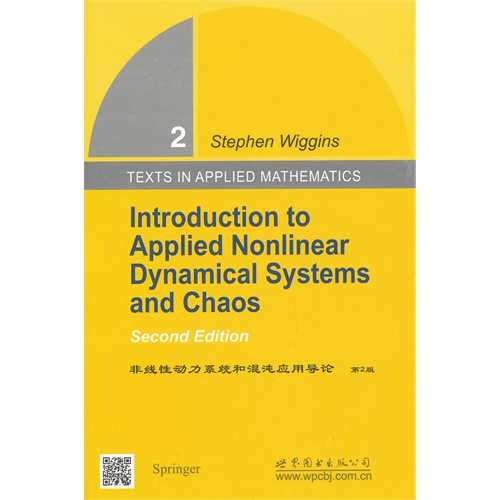- ISBN:9787510058448
- 装帧:一般胶版纸
- 册数:暂无
- 重量:暂无
- 开本:24开
- 页数:843
- 出版时间:2013-03-01
- 条形码:9787510058448 ; 978-7-5100-5844-8
本书特色
维金斯编著的《非线性动力系统和混沌应用导论(第2版)(英文)》的重点讲述大量的技巧和观点,包括了深层次学习本科目的**的核心知识,这些可以使学生能够学习特殊动力系统并获得学习这些系统大量信息。因此,像工程、物理、化学和生物专业读者不需要另外学习大量的预备知识。新的版本中包括了大量有关不变流形理论和规范模的新材料,拉格朗日、哈密尔顿、梯度和可逆动力系统的也有讨论,也包括了哈密尔顿分叉和环映射的基本性质。书中附了丰富的参考资料和详细的术语表,使得《非线性动力系统和混沌应用导论(第2版)(英文)》的可读性更加增大。
内容简介
《非线性动力系统和混沌应用导论(第2版)(英文)》的重点讲述大量的技巧和观点,包括了深层次学习本科目的**的核心知识,这些可以使学生能够学习特殊动力系统并获得学习这些系统大量信息。因此,像工程、物理、化学和生物专业读者不需要另外学习大量的预备知识。新的版本中包括了大量有关不变流形理论和规范模的新材料,拉格朗日、哈密尔顿、梯度和可逆动力系统的也有讨论,也包括了哈密尔顿分叉和环映射的基本性质。书中附了丰富的参考资料和详细的术语表,使得《非线性动力系统和混沌应用导论(第2版)(英文)》的可读性更加增大。
目录
series preface
preface to the second edition
introduction
1 equilibrium solutions,stability,and linearized stability
1.1 equilibria of vector fields
1.2 stability of trajectories
1.2a linearization
1.3 maps。
1.3a definitions of stability for maps
1.3b stability of fixed points of linear maps
1.3c stability of fixed points of maps via the linearapproximation
1.4 some terminology associated with fixed points
1.5 application to the unforced duffing oscillator
1.6 exercises
2 liapunov functions
2.1 exercises
3 invariant manifolds:linear and nonlinear systems
3.1 stable,unstable,and center subspaces of linear,autonomousvector fields
3.1a invariance of the stable,unstable,and center subspaces
3.1b some examples.
3.2 stable,unstable,and center manifolds for fixed points ofnonlinear,autonomous vector fields
3.2a invariance of the graph of a function:tangency of the vectorfield to the graph
3.3 maps
3.4 some examples
3.5 existence of invariant manifolds:the main methods of proof,andhow they wbrk 3:5a application of these two methods to a concreteexample:existence of the unstable manifold
3.6 time-dependent hyperbolic trajectories and their stable andunstable manifoids
3.6a hyperbolic trajectories
3.6b stable and unstable manifolds of hyperbolic trajectories
3.7 invariant manifolds in a broader context
3.8 exercises
4 periodic orbits
4.1 nonexistence of periodic orbits for two-dimensional,autonomousvector fields
4.2 further remarks on periodic orbits
4.3 exercises
5 vector fields possessing an integral
5.1 vector fields on two-manifolds having an integral
5.2 two degree-of-freedom hamiltonian systems and geometry
5.2a dynamics on the energy surface.
5.2b dynamics on an individual torus
5.3 exercises
6 index theory
6.1 exercises
7 some general properties of vector fields:
existence,uniqueness,differentiability,and flows
7.1 existence,uniqueness,differentiability with respect to initialconditions
7.2 continuation of solutions
7.3 differentiability with respect to parameters
7.4 autonomous vector fields
7.5 nonautonomous vector fields
7.5a the skew—product flow approach
7.5b the cocycle approach
7.5c dynamics generated by a bi—infinite sequence of maps
7.6 liouville's theorem
7.6a volume preserving vector fields and the poincar6 recurrencetheorem
7.7 exercises
8 asymptotic behavior
8.1the asymptotic behavior oftrajectories.
8.2 attracting sets,attractors.and basins of attraction
8.3 the lasalle invariance principle
8.4 attraction in nonautonomous systems
8.5 exercises
9 the poinear6-bendixson theorem
9.1 exercises
10 poinear6 maps
10.1 cuse 1:poincar6 map near a periodic orbit
10.2 case 2:the poincar6 map of a time-periodic ordinarydifferential equation
10.2a periodically forced linear oscillators
10.3 case 3:the poincar6 mad near a homoclinic orbit
10.4 case 4:poincar6 map associated with a two degree-of-freedomhamiltonian system
10.4a the study of coupled oscillators via circle maps
10.5 exercises
11 conjugacies of maps,and varying the cross.section
11.1 case 1:poincar6 map near a periodic orbit:variation of thecross—section
11.2 case 2:the poincard map of a time-periodic ordinarydifferential equation:variation of the cross—section
12 structural stability,genericity,and transversality
12.1 definitions of structural stability and genericity。
12.2 transversality
12.3 exercises。。
13 lagrange's equations
13.1 generalized coordinates
13.2 derivation of lagrange's equations
13.2a the kinetic energy
13.3 the energy integral
13.4 momentum integrals
13.5 hamilton's equations
13.6 cyclic coordinates.routh's equations.and reduction of thenumber of equations
13.7 variational methods
13.7a the principle of least action
13.7b the action principle in phase space。
13.7c transformations that preserve the form of hamilton'sequations
13.7d applications of variational methods
13.8 the hamilton.jacobi equation
13.8a applications of the hamilton—jacobi equation
13.9 exercises,
14 hamiltonian vector fields
14.1 symplectic forms
14.1a the relationship between hamilton's equations and thesymplectic form
14.2 poisson brackets
14.2a hamilton’s equations in poisson bracket form
14.3 symplectic or canonical transformations.
14.3a eigenvalues of symplectic matrices
14.3b infinitesimally symplectic transformations
14.3c the eigenvalues of infinitesimally symplectic matrices
14.3d the flow generated by hamiltonian vector fields is aone-parameter famiiy of symplectic transformations
14.4 transformation of hamilton's equations under symplectictransformations
14.4a hamilton's equations in complex coordinates
14.5 completely integrable hamiltonian systems
14.6 dynamics of completely integrable hamiltonian systems inaction—angle coordinates
14.6a resonance and nonresonance
14.6b diophantine frequencies
14.6c geometry of the resonances
14.7 perturbations of completely integrable hamiltonian systems inaction-angle coordinates
14.8 stability of elliptic equilibria
14.9 discrete-time hamiltonian dynamical systems:iteration ofsymplectic maps
14.9a the kam theorem and nekhoroshev's theorem for symplecticmaps.
14.10 genetic properties of hamiltonian dynamical systems
14.11 exercises
15 gradient vector fields
15.1 exercises
16 reversible dynamical systems
16.1 the definition of reversible dynamical systems
16.2 examples of reversible dynamical systems
16.3 linearization of reversible dynamical systems
16.3a continuous time
16.3b discrete time
……
17 asymptotically autonomous vector fields
18 center manifolds
19 normal forms
20 bifurcation of fixed points of vector fields
21 bifurcations of fixed points of maps
23 the smale horseshoe
24 symbolic dynamics
25 the conley-moser conditions,or“how to prove that a dynamicalsystem is chaotic”
26 dynamics near homoclinic points oftwo-dimensional maps
27 orbits homoclinic to hyperbolic fixed points inthree-dimensional autonomous v.ector fields
28 melnikov's method for homoclinic orbits intwo-dimensional,time-periodic vector fields
29 liapunov exponents
30 chaos and strange attractors
31 hyperbolic invariant sets:a chaotic saddle
32 long period sinks in dissipative systems and elliptic islands inconservative systems
33 global bifurcations arising from local codimension--twobifurcations
34 glossary of frequently used terms
bibliography
index
节选
维金斯编著的《非线性动力系统和混沌应用导论(第2版)(英文)》的重点讲述大量的技巧和观点,包括了深层次学习本科目的**的核心知识,这些可以使学生能够学习特殊动力系统并获得学习这些系统大量信息。因此,像工程、物理、化学和生物专业读者不需要另外学习大量的预备知识。新的版本中包括了大量有关不变流形理论和规范模的新材料,拉格朗日、哈密尔顿、梯度和可逆动力系统的也有讨论,也包括了哈密尔顿分叉和环映射的基本性质。书中附了丰富的参考资料和详细的术语表,使得《非线性动力系统和混沌应用导论(第2版)(英文)》的可读性更加增大。
作者简介
Stephen Wiggins是国际知名学者,在数学和物理学界享有盛誉。本书凝聚了作者多年科研和教学成果,适用于科研工作者、高校教师和研究生。
-

铁道之旅:19世纪空间与时间的工业化
¥20.7¥59.0 -

金属材料及热处理
¥46.1¥72.0 -

实用电气计算
¥64.2¥88.0 -

实用精细化学品丛书--陶瓷添加剂:配方·性能·应用(第二版)
¥51.8¥69.0 -

中国传统民俗文化:建筑系列:中国古代桥梁
¥20.9¥58.0 -

嗨印刷工艺(Vol1烫印)(精)
¥147.4¥268.0 -

西门子S7-1200 PLC项目化教程
¥39.4¥54.0 -

气动系统装调与PLC控制
¥29.1¥39.8 -

高聚物粘结及其性能
¥34.8¥120.0 -

液压控制系统
¥12.7¥31.0 -

汽车风云人物
¥20.5¥50.0 -

品牌鞋靴产品策划-从创意到产品
¥26.5¥42.0 -

城市桥梁工程施工与质量验收手册-(含光盘)
¥61.6¥78.0 -

城镇道路工程施工与质量验收规范实施手册
¥16.4¥39.0 -

毛皮加工及质量鉴定
¥1.6¥6.0 -

航空发动机限寿件概率损伤容限评估概述
¥67.8¥88.0 -

天才武器
¥42.0¥60.0 -

中国再制造进展
¥88.5¥118.0 -

中国烹饪工艺学粤菜教程
¥48.4¥59.8 -

欧亚大陆北部的树皮船与兽皮船
¥132.3¥189.0













